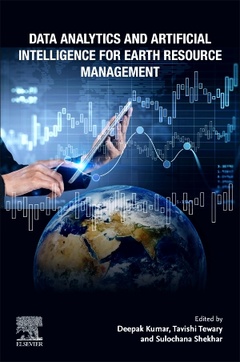Description
Data Analytics and Artificial Intelligence for Earth Resource Management
Coordinators: Kumar Deepak, Tewary Tavishi, Shekhar Sulochana
Language: English
Subject for Data Analytics and Artificial Intelligence for Earth...:
325 p. · 15x22.8 cm · Paperback
Description
/li>Contents
/li>Biography
/li>Comment
/li>
Data Analytics and Artificial Intelligence for Earth Resource Management offers a detailed look at the different ways data analytics and artificial intelligence can help organizations make better-informed decisions, improve operations, and minimize the negative impacts of resource extraction on the environment. The book explains several different ways data analytics and artificial intelligent can improve and support earth resource management. Predictive modeling can organizations help understand the impacts of different management decisions on earth resources, such as water availability, land use, and biodiversity. Resource monitoring tracks the state of earth resources in real-time, identifying issues and opportunities for improvement. Providing managers with real-time data and analytics allows them to make more informed choices. Optimizing resource management decisions help to identify the most efficient and effective ways to allocate resources. Predictive maintenance allows organizations to anticipate when equipment might fail and take action to prevent it, reducing downtime and maintenance costs. Remote sensing with image processing and analysis can be used to extract information from satellite images and other remote sensing data, providing valuable information on land use, water resources, and other earth resources. And most urgently, data analytics and artificial intelligence can model and predict the impacts of climate change on earth resources and help organizations to develop plans to adapt. This text is a vital resource for data scientists, data analysts, engineers, and administrators working in earth resource management.
2. Basics of Earth Resource Management
3. Data Analytics for Earth Resource Management
4. Artificial Intelligence for Earth Resource Management
5. Data Preprocessing Techniques
6. Analytics for Earth Resource Management
7. Machine Learning for Earth Resource Management
8. Deep Learning for Earth Resource Management
9. Natural Language Processing for Earth Resource Management
10. Remote Sensing and Geographic Information System for Earth Resource Management
11. Case Studies
12. Future Trends in Data Analytics and AI for Earth Resource Management
Dr. Tavishi Tewary has over 13 years of experience in policy research and trade impact assessment. She has published various research papers in international journals of high repute. She has also conducted FDPs on Data Analysis using SPSS. She has academic experience teaching postgraduate business school students. She also has experience in providing scientific leadership to high-profile strategic sustainability and conservation initiatives with several years of research experience. Managed cross-sectoral and interdisciplinary teams of professionals to deliver on complex research projects. Currently, she is working as an Assistant Professor and Area Chair Department of Economics
- Comprehensive understanding of data analytics and artificial intelligence (AI) for earth resource management
- Real-world case studies and examples to demonstrate the practical applications of data analytics and AI in earth resource management
- Clear illustrations, diagrams, and pictures make the content more understandable and engaging
These books may interest you

Wetlands and Habitats 184.47 €



